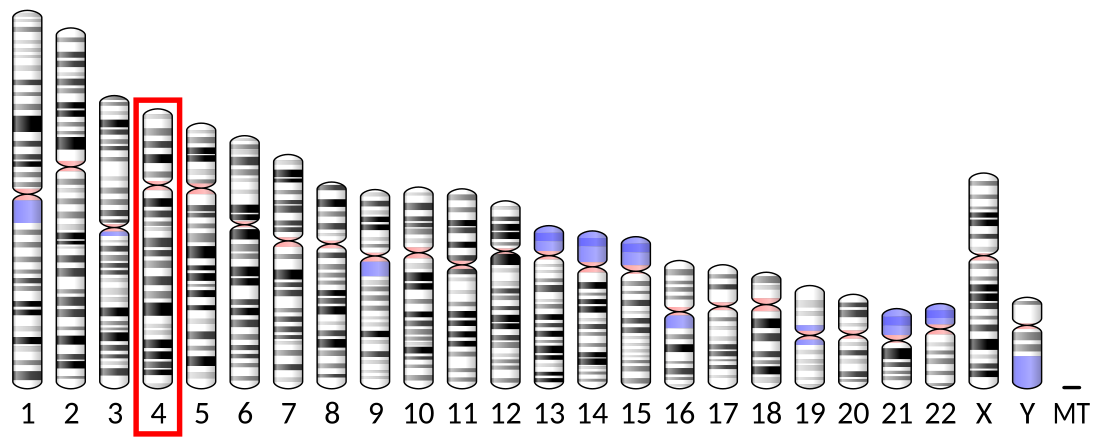Top Qs
Timeline
Chat
Perspective
DMAC1
Protein-coding gene in the species Mus musculus From Wikipedia, the free encyclopedia
Remove ads
Transmembrane protein 261 is a protein that in humans is encoded by the TMEM261 gene located on chromosome 9.[2] TMEM261 is also known as C9ORF123 and DMAC1, Chromosome 9 Open Reading Frame 123 and Transmembrane Protein C9orf123[3] and Distal membrane-arm assembly complex protein 1.[4]
Remove ads
Gene features
TMEM261 is located at 9p24.1, its length is 91,891 base pairs (bp) on the reverse strand.[3] Its neighbouring gene is PTPRD located at 9p23-p24.3 also on the reverse strand and encodes protein tyrosine phosphatase receptor type delta.[2][3] TMEM261 has 2 exons and 1 intron, and 6 primary transcript variants; the largest mRNA transcript variant consisting of 742bp with a protein 129 amino acids (aa) in length and 13,500 daltons (Da) in size, and the smallest coding transcript variant being 381bp with a protein 69aa long and 6,100 Da in size.[5][6]

Remove ads
Protein features
Summarize
Perspective
TMEM261 is a protein consisting out of 112 amino acids, with a molecular weight of 11.8 kDa.[7] The isoelectric point is predicted to be 10.2,[8] whilst its posttranslational modification value is 9.9.[6]
Structure

TMEM261 contains a domain of unknown function, DUF4536 (pfam15055), predicted as a helical membrane spanning domain about 45aa (Cys 47- Ser 92) in length with no known domain relationships.[9][10] Two further transmembrane helical domains are predicted of lengths 18aa (Val 52-Ala 69) and 23aa (Pro 81-Ala 102]).[11][12] There is also a low complexity region spanning 25aa (Thr 14-Ala 39).[13] The tertiary structure for TMEM261 has not yet been determined. However, its protein secondary structure is mostly composed of coiled-coil regions with beta strands and alpha helices found within the transmembrane and domain of unknown function regions. The N-terminal region of TMEM261 is composed of a disordered region[14][15] which contains the low complexity region[13] that is not highly conserved amongst orthologues.[16][17]
Modifications
A N-myristoylation domain is shown to be present in most TMEM261 protein variants.[6] Post-translational modifications include myristoylation of the N-terminal Glycine residue (Gly2)[6][18] of the TMEM261 protein as well as phosphorylation of Threonine 31.[19]
Interactions
Proteins shown to interact with TMEM261 include NAAA (protein-protein interaction), QTRT1 (RNA-protein interaction),ZC4H2(DNA-protein interaction)[20] and ZNF454(DNA-protein interaction).[21][22] It has also shown to interact with APP(protein-protein interaction),[23] ARHGEF38(protein-protein interaction)[24] and HNRNPD(RNA-protein interaction).[25][26]

Additional transcription factor binding sites (DNA-protein interaction) predicted include one binding site for MEF2C a monocyte-specific enhancement factor that is involved in muscle-cell regulation particularly in the cardiovascular system[3][28] and two binding sites for GATA1 which is a globin transcription factor 1 involved in erythroblast development regulation.[29][30][31]
Remove ads
Expression
TMEM261 shows ubiquitous expression in humans and is detected in almost all tissue types.[32][33] It shows tissue-enriched gene (TEG) expression when compared to housekeeping gene (HKG) expression.[27] Its highest expression is seen in the heart (overall relative expression 94%) particularly in heart fibroblast cells, thymus (overall relative expression 90%), and thyroid (overall relative expression 93%) particularly in thyroid glandular cells.[27][32] Staining intensity of cancer cells showed intermediate to high expression in breast, colorectal, ovarian, skin, urothelial, head and neck cells.[32]
Function
Currently the function for TMEM261 is unknown.[34] However, gene amplification and rearrangements of its locus have been associated with various cancers including colorectal cancer,[35] breast cancer[36] and lymphomas.[37][38]
Evolution
Summarize
Perspective
Orthologues
The orthologues and homologues of TMEM261 are limited to vertebrates, its oldest homologue dates to that of the cartilaginous fishes[39] which diverged from Homo sapiens 462.5 million years ago.[40] The protein primary structure of TMEM261 shows higher overall conservation in mammals, however high conservation of the domain of unknown function (DUF4536) to the C-terminus region is seen in all orthologues, including distant homologues. The protein structure of TMEM261 shows conservation across most orthologues.[16][17]
Paralogues
TMEM261 has no known paralogs.[39]
Remove ads
References
External links
Further reading
Wikiwand - on
Seamless Wikipedia browsing. On steroids.
Remove ads


